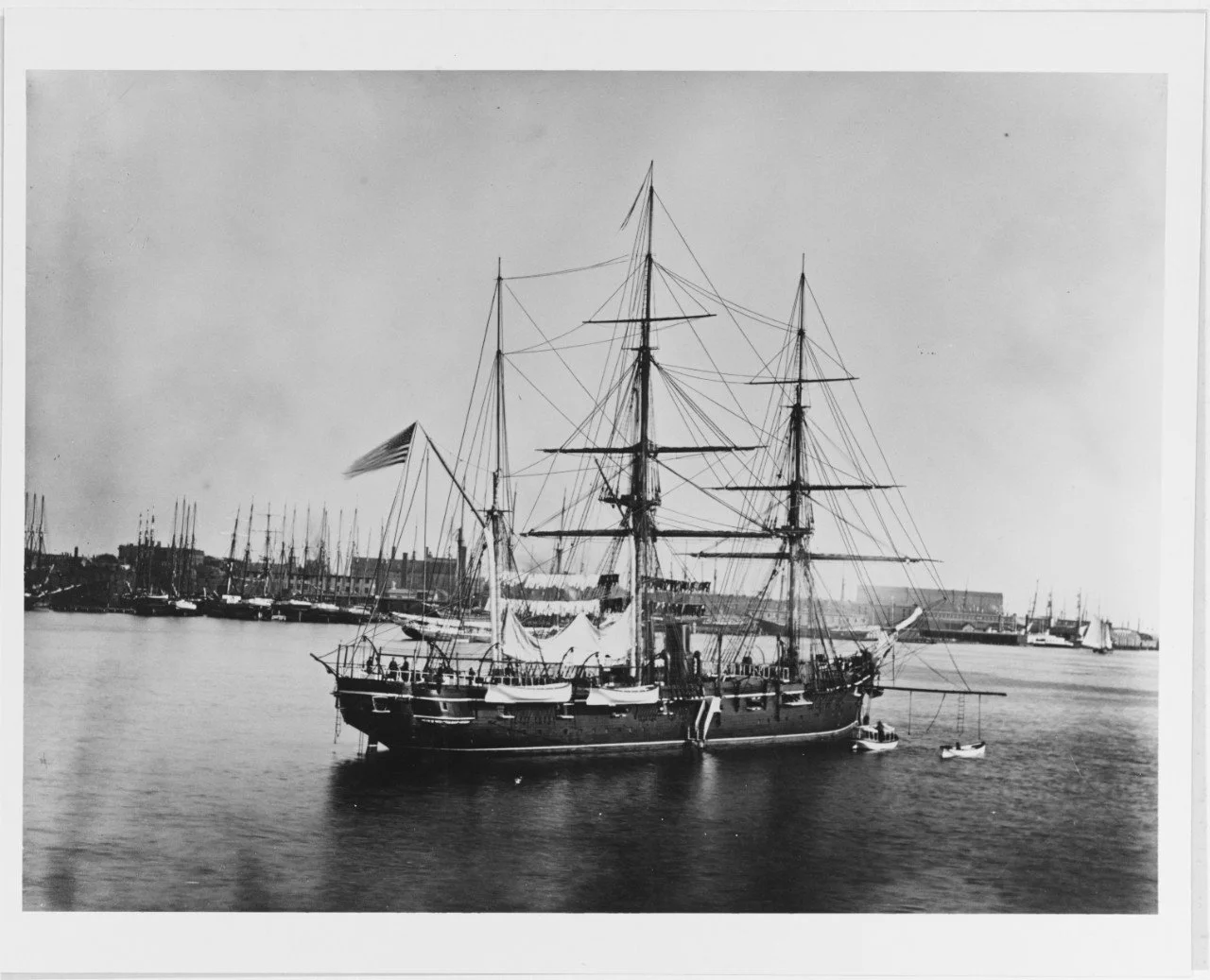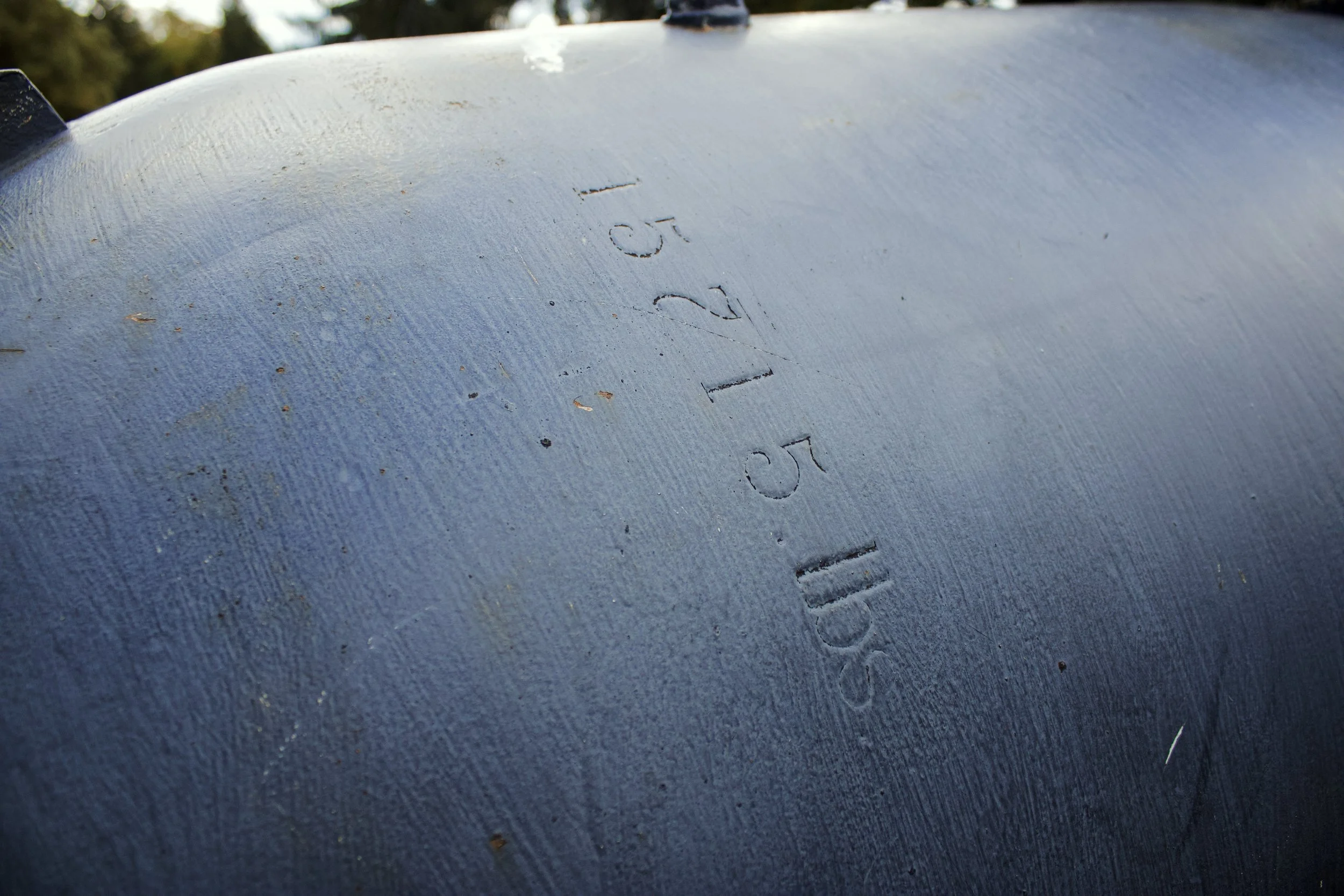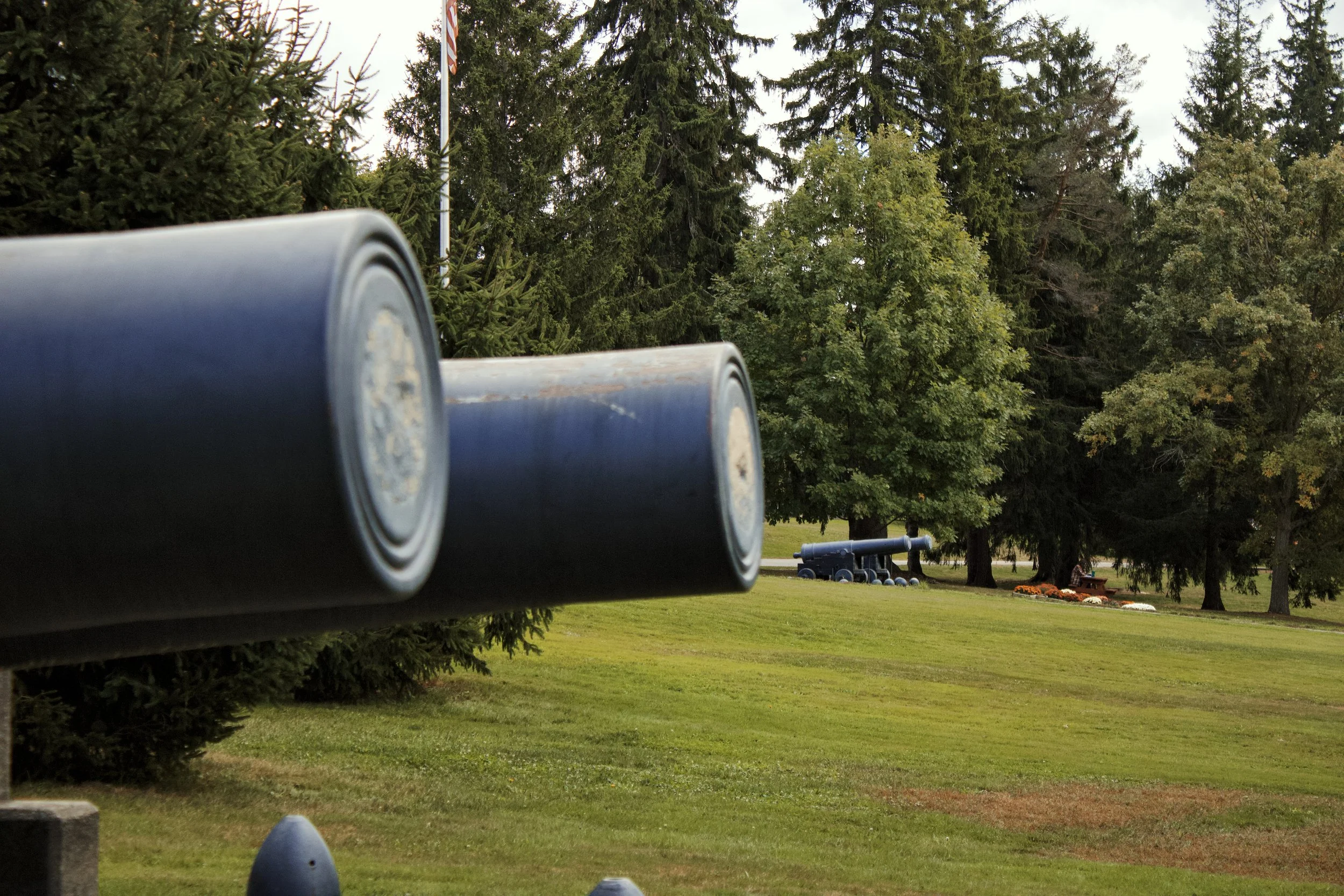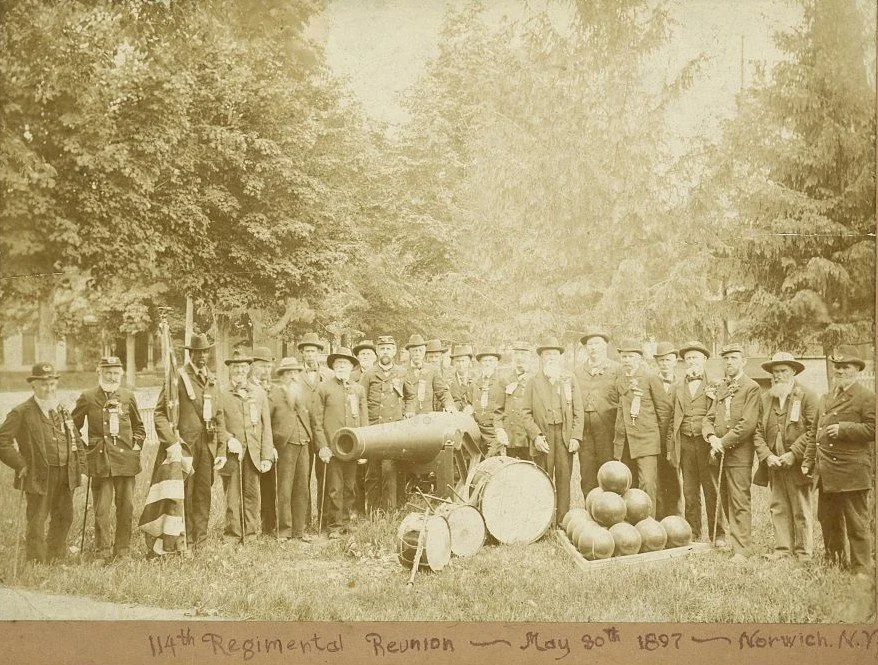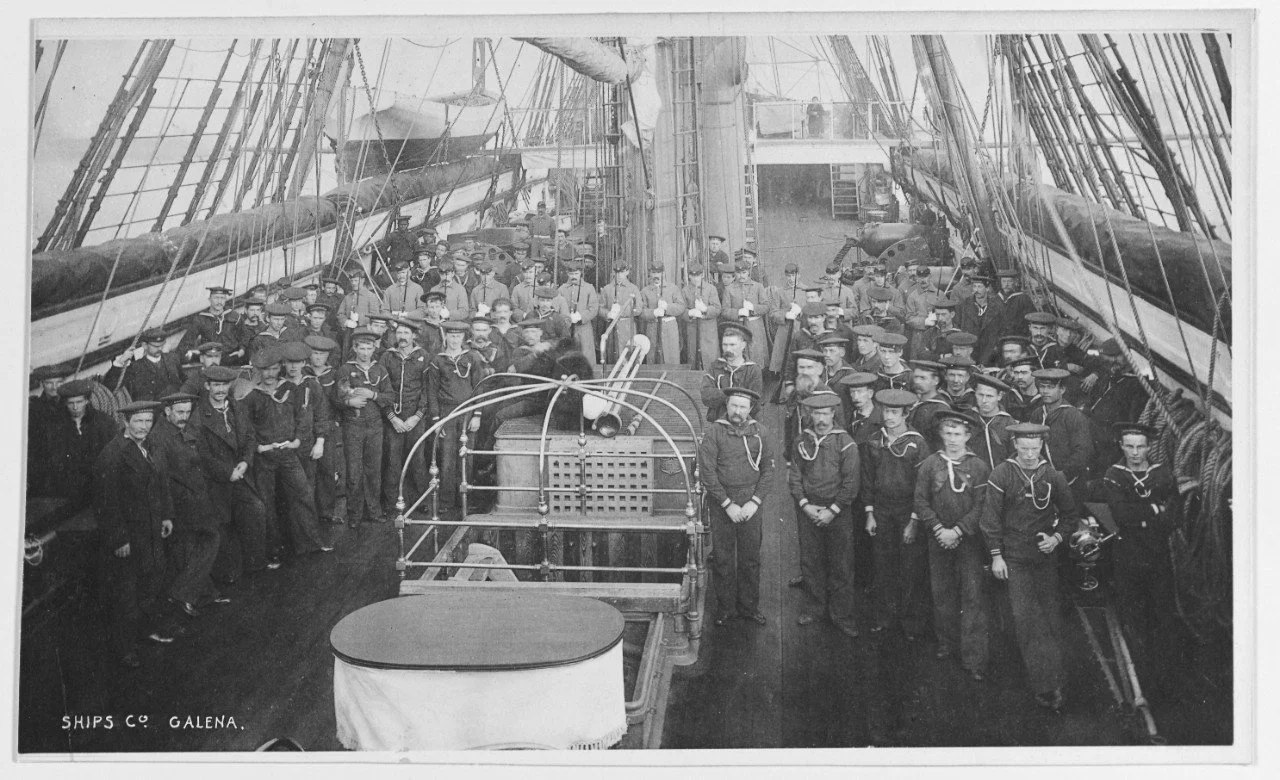The 8-Inch Rifles at the University of Maine
Two US Navy 8-Inch Rifles are displayed at the University of Maine. Photo by Laura Curioli
Two US Navy 8-Inch (180-Pounder) Muzzle Loading Rifles, Registry Numbers 12 and 16, have been displayed at the University of Maine overlooking the Stillwater River in Orono since Llewellyn N. Edwards, Class of 1898, facilitated their donation by the Navy in 1932. Beginning in the fall of 1931, Edwards spent a year coordinating and communicating with and at times cajoling US Navy officers, the president and trustees of the university, the governor and other state officials, and architects and engineers to bring the cannons to the campus.
Edwards sought out the elderly veterans of a Grand Army of the Republic Post in Norway, Maine to make the official request for the cannons to the Navy. His decision to involve the Civil War veterans was a sentimental one. Edwards likely remembered from his youth large gatherings of G.A.R. veterans. By 1931, he had to search to find a G.A.R. post with living veterans capable of taking part is his project which he hoped would honor them.
Having received a list of antique ordnance at the Navy Yards in Portsmouth and Boston, Edwards selected the two largest cannons and two others which were said to have come from USS Constitution for his display. The two Constitution cannons will be the subject of a future post.
List of obsolete cannons available for donation at the Portsmouth and Boston Navy Yards in 1931. Edwards selected the two largest Civil War era cannons and two of the discarded replicas from USS Constitution. From the Raymond H. Fogler Library University Archives.
I would like to thank Ms. Laura Curioli, M.A. University of Maine, for her assistance in photographing the cannons and the original documents relating to the placement of the display.
All correspondence mentioned in this post may be found in the “University of Maine Obsolete Ordnance Correspondence” Collection of the Raymond H. Fogler Library University Archives. The record may be found here: https://archives.library.umaine.edu/repositories/3/resources/2224
Additionally, Archivist Desirée Butterfield-Nagy has written a wonderful article on the donation of the cannons and their place in the history and fabric of the university. I commend the article to you:
“Relics of the Past: University Cannon History Can Be Traced Through Correspondence in University Archive” by Desirée Butterfield-Nagy, archivist, Special Collections Department. The article appeared in The Olive Tree, Vol. 20, Number 2, 2012, Available at: https://digitalcommons.library.umaine.edu/olvt/vol20/iss2/1
Two US Navy 8-Inch Rifles are displayed at the University of Maine. Photo by Laura Curioli
The two cannons were originally cast as 11-Inch Dahlgren Smoothbores by Builders Foundry in Providence, Rhode Island in 1864. This was the same type of cannon which armed USS Monitor (which fought the ex-Merrimack CSS Virginia at the Battle of Hampton Roads) and which was carried aboard USS Kearsarge (which sank CSS Alabama in the Battle of Cherbourg) as well as many other purpose-built US Navy ships during the American Civil War.
US Navy Officer John A. Dahlgren developed a series of cast-iron smoothbore shell guns for the Navy during the 1850s. The distinctive “soda bottle” shape was designed following research that showed that the pressures when firing on the breech of the cannon were far greater than at the muzzle. The 11-Inch cannon was the largest of his original designs. It was designed to be carried in small numbers on the upper decks of larger warships.
Turret of USS Monitor in 1862. USS Monitor was armed with two 11-Inch Dahlgren Smoothbores. As originally manufactured, the two large cannons at the University of Maine would have been identical to Monitor’s cannons. Library of Congress Photo. https://www.santee1821.net/preserved-artillery/the-11-inch-dahlgrens-of-uss-monitor
The specific cannons at the University of Maine were not used during the American Civil War. Neither cannon is listed as having known Civil War service in The National Registry of Known Surviving Civil War Artillery as found in The Big Guns per the research of Wayne E. Stark. An email exchange in January 2025 with the current keeper of the registry, Mr. Jim Bender, confirmed no known Civil War service for either cannon. The Navy would have likely chosen the most recently produced cannons with no sea service as the basis for conversions. Kept in storage during and after the Civil War, they were converted to 8-Inch Rifles by West Point Foundry in 1877.
USS Kearsarge in 1864. Acting Master James R. Wheeler (left) and Assistant Engineer Sidney L. Smith are standing beside the ship's forward 11-inch pivot gun. The aft 11-Inch Dahlgren may also be seen in the photo. Naval History and Heritage Command Photo.
Converting Cannons to be “Drop-In” Armament Upgrades for the US Navy: The ironclad “monitors” built for the US Navy during the Civil War were only suitable for coastal operations and saw little use other than as training vessels post war. In the late 1870s, fifteen years after the Battle of Hampton Roads had established the supremacy of iron armor over wood and of steam over sail, the seagoing fleet of the US Navy was almost entirely composed of wooden ships which spent most of their time under sail to save on the cost of coal. Many of the ships had been built before or during the Civil War. Most tasks on board - including handling cannons - were performed by sailors hauling on ropes or manipulating levers.
The 9-Inch and 11-Inch smoothbores which armed the fleet at the time had been revolutionary when designed by John Dahlgren in the 1850s. They had rendered good service in the Civil War but were hopelessly obsolete by the late 1870s. Europe’s navies were building steel ships armed with a powerful new generation of steel and wrought-iron built-up rifled cannons.
Like the similar US Army program, the US Navy sent existing cast-iron 11-Inch Dahlgren cannons back to the foundry where their barrels were bored out to 13.5 inches. Separately, a new 8-Inch rifled inner barrel (called a “sleeve”) was made of wrought-iron bars machine hammered together. This sleeve fit into the enlarged bore of the old cast-iron cannon. The result was a cannon that (it was hoped) combined the metallurgical strengths of both wrought-iron and cast-iron in a size and shape that was familiar to the sailors of the US Navy and fit upon existing ships and carriages. The program was also intended to be far less expensive than producing or purchasing wholly new modern cannons.
In theory, the newly converted rifled cannon would fire a slightly heavier projectile with greater range, accuracy and power than the old smoothbore. (The old 11-Inch smoothbore fired a round shot weighing about 165 pounds or a shell weighing about 132 pounds. The new 8-Inch projectile was smaller in diameter but much longer and weighed up to 180 pounds.)
An 1877 article in Proceedings and 1880 text book for students at the Naval Academy offer much more detailed descriptions of the conversion process.
Two US Navy 8-Inch Rifles are displayed at the University of Maine. Photo by Laura Curioli
The Cannons at the University of Maine: (Information taken from visible markings on the cannon and The Big Guns, by Olmstead, Stark, and Tucker. pg. 259. US Navy record is page 286 covering 8-Inch Rifles from Record Group 74 Entry 112: Registers of Naval Guns, 1842–1900 at the National Archives. Images of this page may be viewed here.)
Ship names are linked to entries in the Dictionary of American Fighting Ships maintained by the Naval History and Heritage Command of the United States Navy.
8-Inch Rifle Number 12 - (the cannon to the left as viewed from the rear) was cast as an 11-Inch Dahlgren Smoothbore in 1864 by Builders Foundry. As originally manufactured it weighed 15,715 pounds. It’s original US Navy Registry Number was 182. In 1877 it was converted to an 8-Inch Rifle by the West Point Foundry. As converted it weighs 17,230 pounds. Its new US Navy Registry Number is 12. US Navy records show that this cannon served on USS Monongahela from approximately 1877 to 1879, USS Pensacola from July of 1881 to February of 1885, and USS Juniata from April of 1885 to July of 1889. All three were wooden sail-and-steam ships which had seen significant service in the American Civil War.
8-Inch Rifle Number 16 - (the cannon to the right as viewed from the rear) was cast as an 11-Inch Dahlgren Smoothbore in 1864 by Builders Foundry. As originally manufactured it weighed 15,730 pounds. It’s original US Navy Registry Number was 186. In 1877 it was converted to an 8-Inch Rifle by the West Point Foundry. As converted it weighs 17,230 pounds. Its new US Navy Registry Number is 16. US Navy Records show that this cannon was carried aboard the newly built USS Galena from June of 1880 (before she was commissioned) to April of 1891 (after her decommissioning).
USS Galena at Boston in the 1880s. Though a new ship, Galena with her wooden hull and sail-and-steam propulsion was decidedly old fashioned. Her single 8-Inch Rifle, Number 16, was her only somewhat modern cannon with which she might hope to do more than scratch the paint of an iron or steel ship. Naval History and Heritage Command Photo.
Galena was new. However for administrative purposes she was a “repaired” ship dating from the Civil War. Congress was loathe to authorize new ships in this period. Wooden ships rot, and what is considered a good design changed over time. Sometimes a repair was just that, but sometimes it was more cost effective to take a ship to pieces, reuse whatever pieces of wood happed to still be good, and build a new ship in the place of the old. USS Galena was a part of a class of six ships, originally all of very different designs and sizes, which when “repaired” in the late 1870s emerged as six identical vessels. (See Donald L. Canney’s The Old Steam Navy: Frigates, Sloops, and Gunboats, 1815-1885. pg. 151)
“U.S.S. Juniata in the Gulf of Tonquin, China Sea, September 29-30, 1888”. 8-Inch Rifle Number 12 is depicted amidships forward of the funnel. In the full size image, water can be seen breaking over the bow. The life ring floating away from the ship in the foreground bears the ship’s name. A boat is breaking free from a davit at the stern of the ship. Image from: https://www.mutualart.com/Artwork/U-S-S--Juniata-in-the-Gulf-of-Tonquin--C/
8-Inch Rifle aboard USS Enterprise. Both of the University of Maine’s cannons would have been mounted in a similar fashion. The tracks on the deck allow the cannon to be shifted to fire from either side of the ship. The majority of the crew is needed just to provide the strength needed to move the 17,000 pounds of cannon and it’s 7,000 pound iron carriage. Naval History and Heritage Command Photo.
8-Inch Rifle similar to those a the University of Maine aboard USS Kearsarge in 1890. Library of Congress photo. More about this ship and cannon can be found read here: https://www.santee1821.net/preserved-artillery/the-guns-of-uss-kearsarge-in-1894
The right trunnions display the information about the converted cannons: their new US Navy Registry Numbers (12 and 16), their weight (both 17,230 pounds), and their designation (8-Inch Rifle). Photos by Laura Curioli
The left trunnions show the date of conversion, 1877, and the initials of the US Navy Ordnance Inspector who approved the cannon - Francis J. Higginson.
The original weight as 11-Inch smoothbores before conversion remains stamped on the breech of each cannon. Photo by Laura Curioli
The original manufacturer, Builders Foundry, and the original Registry Numbers 182 and 186 remain stamped on the left side of each breech. Photos by Laura Curioli
“P 270” is stamped on the cascabel of Number 12. This notes that the cannon as a preponderance of 270 pounds - meaning that balanced on its trunnions, the breech is 270 pounds heavier than the muzzle.
Additional Photos of 8-Inch Rifles Numbers 12 and 16 at the University of Maine - Photos by Laura Curioli
11-Inch Dahlgren Number 384 at Exeter, New Hampshire. This cannon has a couple features which show it to be an unmodified example - the trunnions are longer for use on wooden carriages rather than post-war iron carriages, and the cannon has mounting points for firing hammers. The 8-Inch Rifle used a friction primer for firing. Additional photos may be seen here.
Compare 8-Inch Rifle Number 12 to the above photo. Though it weights roughly 1,500 pounds more, it will fit in a similar carriage and can be carried by any ship which could carry the unmodified version. Even if it wanted them, the US Navy of the 1870s did not have the money for or ships to carry an entirely new gun system. Photo by Laura Curioli
Muzzle of 8-Inch Rifle Number 50 near Charleston, South Carolina. The tompion on this cannon has been pushed into the barrel - exposing the rifling of the 8-Inch bore. If the bores of the two cannons in Maine were unplugged, they would look identical. Also, end of the wrought-iron rifled sleeve (painted red) is secured to the original cast-iron outer tube by a locking ring (middle ring). Additional photos of the four surviving cannons of USS Lancaster can be found here: https://www.santee1821.net/preserved-artillery/8inch-dahlgren-rifles-at-patriots-point
11-Inch Dahlgren Number 29 in Eldon, Iowa. This unmodified 11-Inch Dahlgren shows the cannon’s smooth bore. The muzzle also lacks the rings of the 8-Inch conversions as it is simply one single piece of cast iron. Fun Fact, Eldon is the site of the house depicted in the background of Grant Wood’s famous painting, American Gothic. More photos of this cannon can be found here: https://www.santee1821.net/preserved-artillery/the-11-inch-dahlgren-of-eldon-iowa
Cutaway drawing on page 80 of A Text Book of Naval Ordnance and Gunnery Prepared for the Use of Cadet Midshipmen of the United States Naval Academy showing the construction of the 8-Inch Muzzle Loading Rifle from an 11-Inch Dahlgren. The wrought iron rifled sleeve can be seen inside the enlarged cast iron barrel.
Soldiers’ and Sailors’ Monument in Webster, Massachusetts. Not every community could afford such a grand monument. My post on this monument and the cannons nearby may be found here: https://www.santee1821.net/preserved-artillery/the-dahlgren-boat-howitzers-of-webster-massachusetts
Why cannons as memorials?
Communities began erecting monuments to fallen soldiers - and eventually all veterans - in the years following the American Civil War. Major cities and wealthy communities could afford massive stone pillars with bespoke sculptures in bronze and marble by noted artists. Rural county seat towns might have a simple pillar with a mass-produced statue of a generic soldier, but even these more humble monuments were beyond the means of many communities. On May 22nd, 1896 an Act of Congress of provided that any G.A.R. Post, other veterans organization, or memorial committee could apply for an obsolete cannon from the Army or Navy. The only cost would be that of shipping the cannon and installing it upon an appropriate pedestal. Thousands of cannons were donated by the government to communities. Some were placed to augment an existing monument, but for many small communities, veterans organizations, and cemeteries, the cannon - with a small dedication plaque - was the monument.
114th New York Reunion Veterans standing around a US Navy cannon likely recently placed as a memorial in Norwich, New York. In 1942, President Roosevelt made an appeal to communities to turn in their old cannons for scrap as the United States faced a shortage of metals. Like roughly half of the cannons placed as memorials, this one in Norwich seems to have been scrapped. Library of Congress Photo
For Display Purposes Only
Most amusing to me are the repeated instructions in correspondence from the Navy with the members of the G.A.R. post that the cannons are to be used “for display purposes only.” While the 90-year-old veterans may have had no intention of violating that rule, accounts of veterans gatherings from the 1870s do mention cannons being fired in celebration, sometimes after many good refreshments were enjoyed. (Translation, back when the vets were younger they kicked back a few drinks and decided it would be a good idea to fill any cannon at hand with whatever explosive was at hand for a celebratory “boom”. The Navy really didn’t want them to do that anymore. The muzzles of the cannons at the University are plugged to prevent students from getting a similar idea.)
The Crew of USS Galena in the 1880s and their Monument in Maine
The mizzentopmen of USS Galena with a pet goat - Naval History and Heritage Command Photo.
One might question why the four cannons at the University of Maine matter. The two “Old Ironsides” cannons were only ever replicas for display. The two 8-Inch Rifles were made, in their original form, for the Civil War but did not see service in that conflict. Indeed, the Navy did not do much in the way of fighting in the 1870s and 1880s, and it is entirely possible that neither of the cannons ever fired a shot except in practice.
The cannons date from a time when the United States operated wooden ships mostly under sail in a world in which technology was developing rapidly towards steam and steel. They remind us of of a time when the United States had limited international ambitions and was content to be represented by such modest ships.
Very little survives of the “Old Steam Navy”. No museum ship from this period exists in the United States. USS Hartford, the last survivor, was allowed to sink at her moorings at Norfolk in the 1950s. USS Kearsarge, still serving on active duty in 1894, ran upon a reef in the Caribbean and sank, which marooned her crew on the reef for a week. Most of the ships were broken up without ceremony or burned to recover their metal components. Time and technology had passed them by.
While the Veterans of the Civil War are remembered with monuments which remain to this day, the sailors who served in the old wooden ships in the decades following the war were never so celebrated. The crew members of USS Galena, shown in photos above and below, may have as their only public memorial a cannon at the University of Maine.
Apprentice Sailors aboard USS Galena in the 1880s. Naval History and Heritage Command Photo
Ships Company of USS Galena in the 1880s. The cannons visible are the smaller 9-Inch Dahlgrens on the broadside. The 8-Inch Rifle is stored amidships forward of the funnel and therefore is out of view. It’s pivoting tracks can be seen on the deck. Naval History and Heritage Command Photo
African American Sailors of USS Galena, 1880s. Naval History and Heritage Command Photo
Ships Company of USS Galena in the 1880s. Naval History and Heritage Command Photo.
USS Galena’s Goat and Bear in the 1880s. Naval History and Heritage Command Photo
Foretopmen of USS Galena in the 1880s - with goat. Naval History and Heritage Command Photo
Maintopmen of USS Galena in the 1880s. Naval History and Heritage Command Photo
Berth Deck cooks of USS Galena in the 1880s.
Marines aboard USS Galena, 1880s
Officers, Marines, and Sailors aboard USS Galena in the 1880s. Naval History and Heritage Command Photo
This bronze plaque sits between the two cannons. If I could edit the plaque, I would describe them as “US Navy Cannons of USS Galena and USS Juniata - Civil War Era.” That’s close enough.

